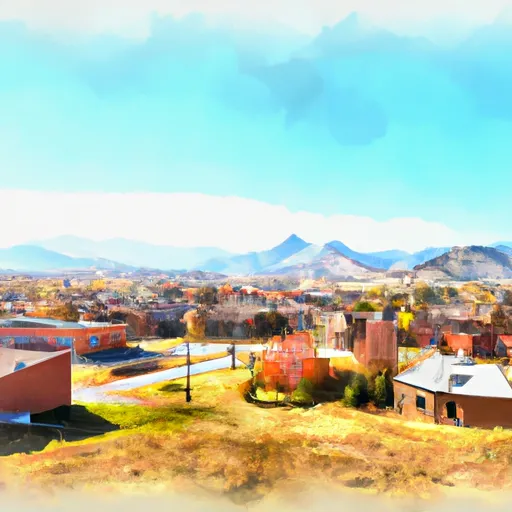-
 Snoflo Premium
Snoflo Premium
Get unlimited access to all our content
With no Ad interruptions! - Start Your Free Trial Login with existing account
Weston
Eden Index
Climate
8.2
•
Recreation
6.5
•
Community
•
Safeguard
5.5/10

Weston, Colorado is a small town located in Las Animas County. It has a semi-arid climate with hot summers and mild winters. The average annual temperature is around 50°F, with temperatures reaching the 90s in summer and dropping to the 20s in winter. Precipitation is limited, averaging around 15 inches per year, with most of it occurring during the summer months.
The hydrology constituents in Weston are mainly influenced by the Purgatoire River, which runs through the town. This river provides a water source for the community and supports local wildlife. Additionally, there are a few small streams and ponds in the area that contribute to the hydrology.
Outdoor recreation opportunities in Weston are abundant. The town is surrounded by picturesque landscapes, making it an ideal destination for activities such as hiking, camping, and wildlife viewing. The nearby Spanish Peaks Wilderness offers a range of trails for all skill levels, allowing visitors to explore the beautiful mountain scenery. Fishing enthusiasts can enjoy angling in the Purgatoire River, known for its trout population. Weston is also close to several national parks and forests, providing opportunities for further exploration and outdoor adventures.
What is the Eden Index?
The Snoflo Eden Index serves as a comprehensive rating system for regions, evaluating their desirability through a holistic assessment of climate health, outdoor recreation opportunities, and natural disaster risk, acknowledging the profound impact of these factors on livability and well-being.
Climate Health Indicator (CHI): 8.2
Weston receives approximately
503mm of rain per year,
with humidity levels near 73%
and air temperatures averaging around
8°C.
Weston has a plant hardyness factor of
6, meaning
plants and agriculture in this region thrive during a short period during spring and early summer. Most
plants will die off during the colder winter months.
By considering the ideal temperature range, reliable water supplies, clean air, and stable seasonal rain or snowpacks, the Climate Health Indicator (CHI) underscores the significance of a healthy climate as the foundation for quality living.
A healthy climate is paramount for ensuring a high quality of life and livability in a region, fostering both physical well-being and environmental harmony. This can be characterized by ideal temperatures, reliable access to water supplies, clean air, and consistent seasonal rain or snowpacks.
Weather Forecast
Streamflow Conditions
Upper Arkansas
Area Rivers
Upper Arkansas
Snowpack Depths
Upper Arkansas
Reservoir Storage Capacity
Upper Arkansas
Groundwater Levels
Recreational Opportunity Index (ROI): 6.5
The Recreational Opportunity Index (ROI) recognizes the value of outdoor recreational options, such as parks, hiking trails, camping sites, and fishing spots, while acknowledging that climate plays a pivotal role in ensuring the comfort and consistency of these experiences.
Access to outdoor recreational opportunities, encompassing activities such as parks, hiking, camping, and fishing, is crucial for overall well-being, and the climate plays a pivotal role in enabling and enhancing these experiences, ensuring that individuals can engage in nature-based activities comfortably and consistently.
Camping Areas
| Campground | Campsites | Reservations | Toilets | Showers | Elevation |
|---|---|---|---|---|---|
| Greenhorn Meadows Park | 26 | 5,938 ft | |||
| Southside - Lake Isabel | 8 | 8,551 ft | |||
| St. Charles | 15 | 8,636 ft | |||
| Purgatoire | 23 | 9,748 ft | |||
| Bear Lake | 14 | 10,482 ft | |||
| McCrystal | 60 | 8,147 ft | |||
| Monument Lake Park | None | 8,621 ft | |||
| Cimarron Canyon State Park | 88 | 7,544 ft | |||
| La Vista - Lake Isabel | 29 | 8,592 ft | |||
| Blue Lake | 16 | 10,492 ft |
Nearby Ski Areas
Catastrophe Safeguard Index (CSI):
The Catastrophe Safeguard Index (CSI) recognizes that natural disaster risk, encompassing floods, fires, hurricanes, and tornadoes, can drastically affect safety and the overall appeal of an area.
The level of natural disaster risk in a region significantly affects safety and the overall livability, with climate change amplifying these risks by potentially increasing the frequency and intensity of events like floods, fires, hurricanes, and tornadoes, thereby posing substantial challenges to community resilience and well-being.
Community Resilience Indicator (CRI):
The Community Resilience Indicator (CRI) recognizes that education, healthcare, and socioeconomics are crucial to the well-being of a region. The CRI acknowledges the profound impact of these elements on residents' overall quality of life. By evaluating educational resources, healthcare accessibility, and economic inclusivity, the index captures the essential aspects that contribute to a thriving community, fostering resident satisfaction, equity, and social cohesion.

